Zeynep Akata
Training-free Uncertainty Guidance for Complex Visual Tasks with MLLMs
Oct 01, 2025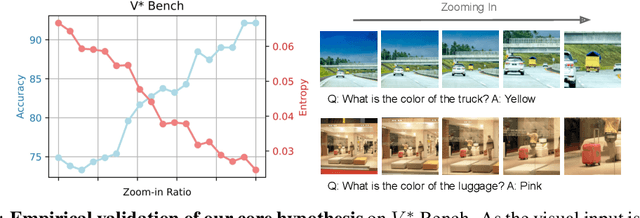
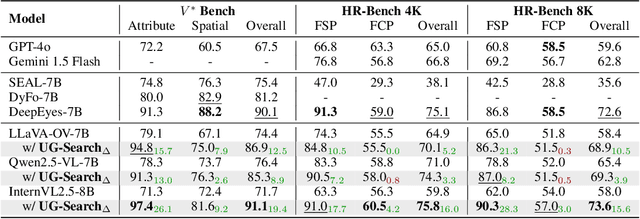
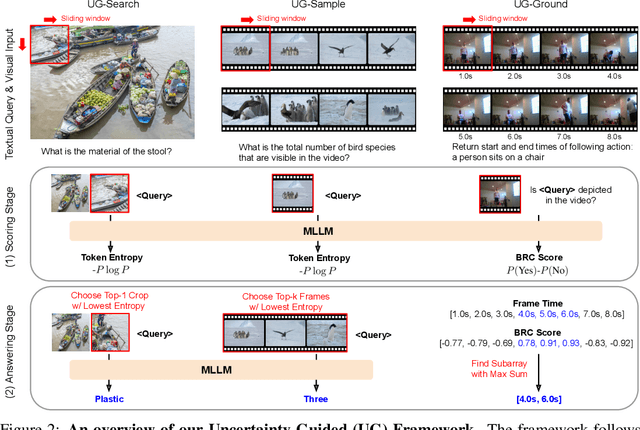

Abstract:Multimodal Large Language Models (MLLMs) often struggle with fine-grained perception, such as identifying small objects in high-resolution images or finding key moments in long videos. Existing works typically rely on complicated, task-specific fine-tuning, which limits their generalizability and increases model complexity. In this work, we propose an effective, training-free framework that uses an MLLM's intrinsic uncertainty as a proactive guidance signal. Our core insight is that a model's output entropy decreases when presented with relevant visual information. We introduce a unified mechanism that scores candidate visual inputs by response uncertainty, enabling the model to autonomously focus on the most salient data. We apply this simple principle to three complex visual tasks: Visual Search, Long Video Understanding, and Temporal Grounding, allowing off-the-shelf MLLMs to achieve performance competitive with specialized, fine-tuned methods. Our work validates that harnessing intrinsic uncertainty is a powerful, general strategy for enhancing fine-grained multimodal performance.
Stitch: Training-Free Position Control in Multimodal Diffusion Transformers
Sep 30, 2025Abstract:Text-to-Image (T2I) generation models have advanced rapidly in recent years, but accurately capturing spatial relationships like "above" or "to the right of" poses a persistent challenge. Earlier methods improved spatial relationship following with external position control. However, as architectures evolved to enhance image quality, these techniques became incompatible with modern models. We propose Stitch, a training-free method for incorporating external position control into Multi-Modal Diffusion Transformers (MMDiT) via automatically-generated bounding boxes. Stitch produces images that are both spatially accurate and visually appealing by generating individual objects within designated bounding boxes and seamlessly stitching them together. We find that targeted attention heads capture the information necessary to isolate and cut out individual objects mid-generation, without needing to fully complete the image. We evaluate Stitch on PosEval, our benchmark for position-based T2I generation. Featuring five new tasks that extend the concept of Position beyond the basic GenEval task, PosEval demonstrates that even top models still have significant room for improvement in position-based generation. Tested on Qwen-Image, FLUX, and SD3.5, Stitch consistently enhances base models, even improving FLUX by 218% on GenEval's Position task and by 206% on PosEval. Stitch achieves state-of-the-art results with Qwen-Image on PosEval, improving over previous models by 54%, all accomplished while integrating position control into leading models training-free. Code is available at https://github.com/ExplainableML/Stitch.
Road Obstacle Video Segmentation
Sep 16, 2025Abstract:With the growing deployment of autonomous driving agents, the detection and segmentation of road obstacles have become critical to ensure safe autonomous navigation. However, existing road-obstacle segmentation methods are applied on individual frames, overlooking the temporal nature of the problem, leading to inconsistent prediction maps between consecutive frames. In this work, we demonstrate that the road-obstacle segmentation task is inherently temporal, since the segmentation maps for consecutive frames are strongly correlated. To address this, we curate and adapt four evaluation benchmarks for road-obstacle video segmentation and evaluate 11 state-of-the-art image- and video-based segmentation methods on these benchmarks. Moreover, we introduce two strong baseline methods based on vision foundation models. Our approach establishes a new state-of-the-art in road-obstacle video segmentation for long-range video sequences, providing valuable insights and direction for future research.
Noise Hypernetworks: Amortizing Test-Time Compute in Diffusion Models
Aug 13, 2025Abstract:The new paradigm of test-time scaling has yielded remarkable breakthroughs in Large Language Models (LLMs) (e.g. reasoning models) and in generative vision models, allowing models to allocate additional computation during inference to effectively tackle increasingly complex problems. Despite the improvements of this approach, an important limitation emerges: the substantial increase in computation time makes the process slow and impractical for many applications. Given the success of this paradigm and its growing usage, we seek to preserve its benefits while eschewing the inference overhead. In this work we propose one solution to the critical problem of integrating test-time scaling knowledge into a model during post-training. Specifically, we replace reward guided test-time noise optimization in diffusion models with a Noise Hypernetwork that modulates initial input noise. We propose a theoretically grounded framework for learning this reward-tilted distribution for distilled generators, through a tractable noise-space objective that maintains fidelity to the base model while optimizing for desired characteristics. We show that our approach recovers a substantial portion of the quality gains from explicit test-time optimization at a fraction of the computational cost. Code is available at https://github.com/ExplainableML/HyperNoise
SUB: Benchmarking CBM Generalization via Synthetic Attribute Substitutions
Jul 31, 2025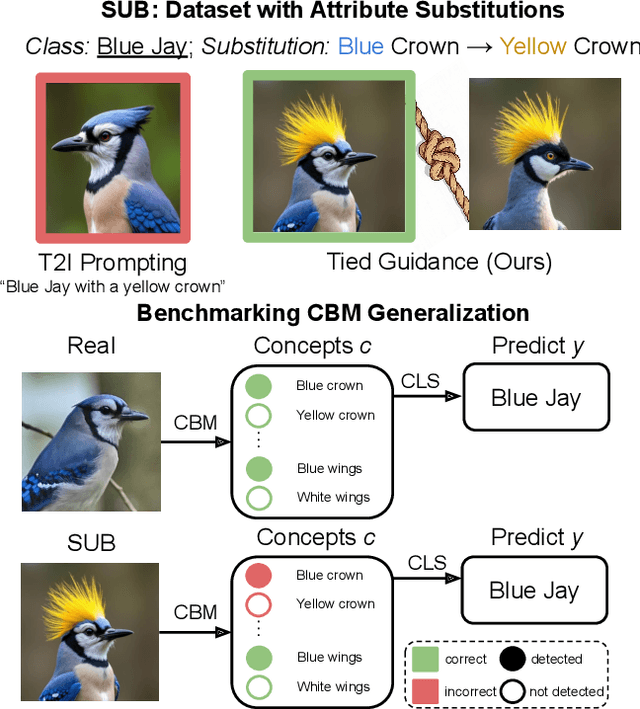
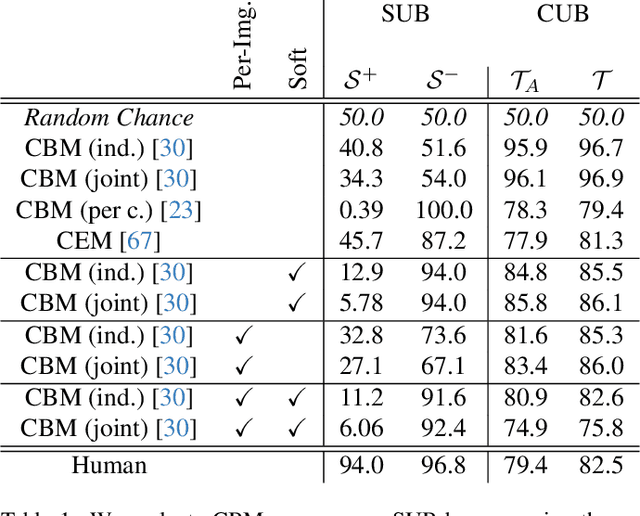
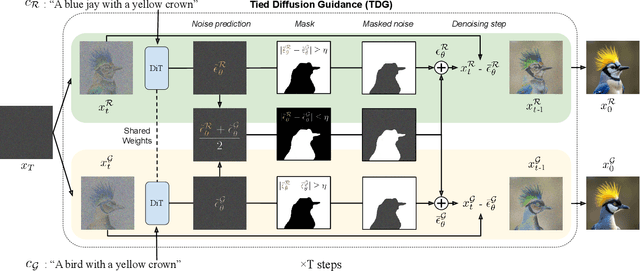

Abstract:Concept Bottleneck Models (CBMs) and other concept-based interpretable models show great promise for making AI applications more transparent, which is essential in fields like medicine. Despite their success, we demonstrate that CBMs struggle to reliably identify the correct concepts under distribution shifts. To assess the robustness of CBMs to concept variations, we introduce SUB: a fine-grained image and concept benchmark containing 38,400 synthetic images based on the CUB dataset. To create SUB, we select a CUB subset of 33 bird classes and 45 concepts to generate images which substitute a specific concept, such as wing color or belly pattern. We introduce a novel Tied Diffusion Guidance (TDG) method to precisely control generated images, where noise sharing for two parallel denoising processes ensures that both the correct bird class and the correct attribute are generated. This novel benchmark enables rigorous evaluation of CBMs and similar interpretable models, contributing to the development of more robust methods. Our code is available at https://github.com/ExplainableML/sub and the dataset at http://huggingface.co/datasets/Jessica-bader/SUB.
Investigating Structural Pruning and Recovery Techniques for Compressing Multimodal Large Language Models: An Empirical Study
Jul 28, 2025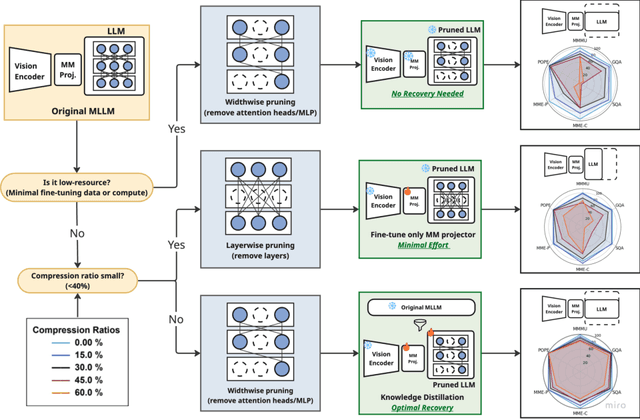
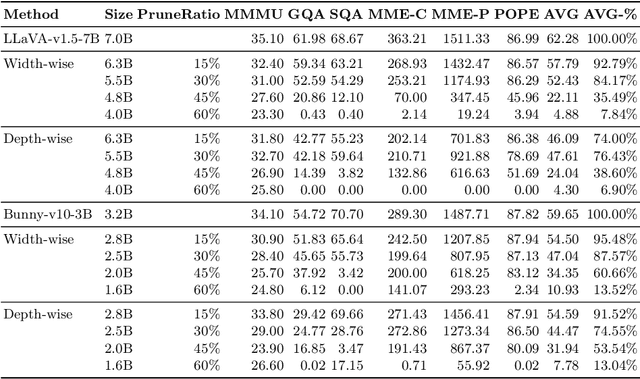
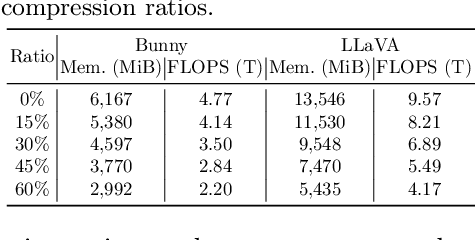

Abstract:While Multimodal Large Language Models (MLLMs) demonstrate impressive capabilities, their substantial computational and memory requirements pose significant barriers to practical deployment. Current parameter reduction techniques primarily involve training MLLMs from Small Language Models (SLMs), but these methods offer limited flexibility and remain computationally intensive. To address this gap, we propose to directly compress existing MLLMs through structural pruning combined with efficient recovery training. Specifically, we investigate two structural pruning paradigms--layerwise and widthwise pruning--applied to the language model backbone of MLLMs, alongside supervised finetuning and knowledge distillation. Additionally, we assess the feasibility of conducting recovery training with only a small fraction of the available data. Our results show that widthwise pruning generally maintains better performance in low-resource scenarios with limited computational resources or insufficient finetuning data. As for the recovery training, finetuning only the multimodal projector is sufficient at small compression levels (< 20%). Furthermore, a combination of supervised finetuning and hidden-state distillation yields optimal recovery across various pruning levels. Notably, effective recovery can be achieved with as little as 5% of the original training data, while retaining over 95% of the original performance. Through empirical study on two representative MLLMs, i.e., LLaVA-v1.5-7B and Bunny-v1.0-3B, this study offers actionable insights for practitioners aiming to compress MLLMs effectively without extensive computation resources or sufficient data.
Align-then-Unlearn: Embedding Alignment for LLM Unlearning
Jun 16, 2025Abstract:As large language models (LLMs) are trained on massive datasets, they have raised significant privacy and ethical concerns due to their potential to inadvertently retain sensitive information. Unlearning seeks to selectively remove specific data from trained models, such as personal information or copyrighted content. Current approaches targeting specific output sequences at the token level often fail to achieve complete forgetting and remain susceptible to prompt rephrasing. We propose Align-then-Unlearn, a novel framework that performs unlearning in the semantic embedding space rather than directly on output tokens. Align-then-Unlearn first augments the LLM with an embedding prediction module trained to anticipate future context representations. Unlearning is then achieved by fine-tuning the model to minimize the similarity between these predicted embeddings and a target embedding that represents the concept to be removed. Initial results show that Align-then-Unlearn effectively removes targeted knowledge with minimal degradation in overall model utility. These findings suggest that embedding-based unlearning offers a promising and robust approach to removing conceptual knowledge. Our code is available at https://github.com/ExplainableML/align-then-unlearn.
Time Series Representations for Classification Lie Hidden in Pretrained Vision Transformers
Jun 10, 2025Abstract:Time series classification is a fundamental task in healthcare and industry, yet the development of time series foundation models (TSFMs) remains limited by the scarcity of publicly available time series datasets. In this work, we propose Time Vision Transformer (TiViT), a framework that converts time series into images to leverage the representational power of frozen Vision Transformers (ViTs) pretrained on large-scale image datasets. First, we theoretically motivate our approach by analyzing the 2D patching of ViTs for time series, showing that it can increase the number of label-relevant tokens and reduce the sample complexity. Second, we empirically demonstrate that TiViT achieves state-of-the-art performance on standard time series classification benchmarks by utilizing the hidden representations of large OpenCLIP models. We explore the structure of TiViT representations and find that intermediate layers with high intrinsic dimension are the most effective for time series classification. Finally, we assess the alignment between TiViT and TSFM representation spaces and identify a strong complementarity, with further performance gains achieved by combining their features. Our findings reveal yet another direction for reusing vision representations in a non-visual domain.
DD-Ranking: Rethinking the Evaluation of Dataset Distillation
May 19, 2025



Abstract:In recent years, dataset distillation has provided a reliable solution for data compression, where models trained on the resulting smaller synthetic datasets achieve performance comparable to those trained on the original datasets. To further improve the performance of synthetic datasets, various training pipelines and optimization objectives have been proposed, greatly advancing the field of dataset distillation. Recent decoupled dataset distillation methods introduce soft labels and stronger data augmentation during the post-evaluation phase and scale dataset distillation up to larger datasets (e.g., ImageNet-1K). However, this raises a question: Is accuracy still a reliable metric to fairly evaluate dataset distillation methods? Our empirical findings suggest that the performance improvements of these methods often stem from additional techniques rather than the inherent quality of the images themselves, with even randomly sampled images achieving superior results. Such misaligned evaluation settings severely hinder the development of DD. Therefore, we propose DD-Ranking, a unified evaluation framework, along with new general evaluation metrics to uncover the true performance improvements achieved by different methods. By refocusing on the actual information enhancement of distilled datasets, DD-Ranking provides a more comprehensive and fair evaluation standard for future research advancements.
Feasibility with Language Models for Open-World Compositional Zero-Shot Learning
May 16, 2025Abstract:Humans can easily tell if an attribute (also called state) is realistic, i.e., feasible, for an object, e.g. fire can be hot, but it cannot be wet. In Open-World Compositional Zero-Shot Learning, when all possible state-object combinations are considered as unseen classes, zero-shot predictors tend to perform poorly. Our work focuses on using external auxiliary knowledge to determine the feasibility of state-object combinations. Our Feasibility with Language Model (FLM) is a simple and effective approach that leverages Large Language Models (LLMs) to better comprehend the semantic relationships between states and objects. FLM involves querying an LLM about the feasibility of a given pair and retrieving the output logit for the positive answer. To mitigate potential misguidance of the LLM given that many of the state-object compositions are rare or completely infeasible, we observe that the in-context learning ability of LLMs is essential. We present an extensive study identifying Vicuna and ChatGPT as best performing, and we demonstrate that our FLM consistently improves OW-CZSL performance across all three benchmarks.
 Add to Chrome
Add to Chrome Add to Firefox
Add to Firefox Add to Edge
Add to Edge